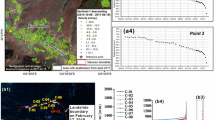Abstract
To monitor land deformation in detail, we ran a large-scale field test in which an artificial landslide was induced by the application of a load to a natural slope. The measured landslide displacement was reproduced numerically through the use of finite element model analysis with a two-dimensional elasto-viscoplastic model. The analysis suggested that the strength of the sliding surface decreased as the landslide mass moved. We propose a simple method for estimating safety factors. The method involves back-calculation of shear strength parameters through reproduction of observed landslide displacements and calculating the ratio of driving force to resisting force acting on the sliding surface as modeled by joint elements. This ratio, the “stability index”, shows the same trend as safety factors calculated by a two-dimensional limit equilibrium method and a shear strength reduction method that use back-calculated shear strength parameters estimated from the limit equilibrium state. The results indicate that the stability index may be applicable to the assessment of slope stability.
















Similar content being viewed by others
References
Barton N, Bandis S, Bakhtar K (1985) Strength deformation and conductivity coupling of rock joints. Int J Rock Mech Min Sci Geomech Abstr 22(3):121–140
Cheng YM, Lansivaara T, Wei WB (2007) Two-dimensional slope stability analysis by limit equilibrium and strength reduction methods. Comput Geotechnics 34(3):137–150
Dawson EM, Roth WH, Drescher A (1999) Slope stability analysis by strength reduction. Geotechnique 49(6):835–840
Duncan JM (1996) Soil slope stability analysis. In: Turner AK, Schuster RL (eds) Landslides investigation and mitigation. Special Report 247, Transportation Research Board, National Research Council, Washington DC, pp 337–371
Fredlund DG, Scoular REG (1999) Using limit equilibrium concepts in finite element slope stability analysis. In: Yagi N, Yamagami T, Jiang JC (eds) Slope stability engineering. A. A Balkema, Rotterdam, pp 31–47
Goodman RE, Taylor RL, Brekke TL (1968) A model for the mechanics of jointed rock. J Soil Mech Found Div 94(SM3):637–659
Griffiths DV, Lane PA (1999) Slope stability analysis by finite elements. Geotechnique 49(3):387–403
Hunt RE (1984) Geotechnical engineering investigation handbook. McGraw-Hill, New York, p 206
Ishii Y, Fujisawa K, Nakashima Y, Kuraoka S (2006) Finite element analysis of restraint piles and landslide triggered by groundwater. JLS 43(2):51–59 (in Japanese)
Ishii Y, Tsunaki R, Asano H, Sugimoto H (2001) Characteristics of landslide movement during filling observed through field loading test. Civil Eng J 43(11):32–37 (in Japanese)
Ishii Y, Tsunaki R, Sugimoto H, Asano H, Osanai N (2005) Effect of analysis method for safety factor of landslide obtained through field loading test. JLS 41(6):595–606 (in Japanese)
Japanese Geotechnical Society (2004) Method for engineering classification of rock mass (JGS: 3811–2004). Japan Geotech Soc, Tokyo, pp 39–41
Morgenstern NR, Price VE (1965) The analysis of the stability of general sliding surfaces. Geotechnique 15(1):79–93
NILIM (National Institute for Land Infrastructure Management) and PWRI (Public Works Research Institute) (2009) Ministry of Land, Infrastructure, Transport and Tourism technical criteria for river works: practical guide for planning. Technical note of NILIM No. 519 and PWRI No. 4132, p 196
Owen J, Hinton E (1980) Finite elements plasticity; theory & practice. Pineridge, Swansea, pp 272–318
Sekiguchi K, Rowe RK, Lo KY (1990) Time step s election for 6 noded non-linear joint element in elasto-viscoplasticity analyses. Comput Geotech 10(1):33–58
Tsuchiya S, Sasahara K, Shuin S, Ozono S (2009) The large-scale landslide on the flank of caldera in South Sulawesi, Indonesia. Landslides 6(1):83–88
Ugai K, Leshchinsky D (1995) Three-dimensional limit equilibrium and finite element analysis: a comparison of results. Soils Foundations 35(4):1–7
Matsui T, San KC (1992) Finite element slope stability analysis by shear strength reduction technique. Soils Foundations 32(1):59–70
Zienkiewicz OC, Humpheerson C, Lewis RW (1975) Associated and non-associated visco-plasticity and plasticity in soil mechanics. Geotechnique 25(4):671–689
Author information
Authors and Affiliations
Corresponding author
Rights and permissions
About this article
Cite this article
Ishii, Y., Ota, K., Kuraoka, S. et al. Evaluation of slope stability by finite element method using observed displacement of landslide. Landslides 9, 335–348 (2012). https://doi.org/10.1007/s10346-011-0303-7
Received:
Accepted:
Published:
Issue Date:
DOI: https://doi.org/10.1007/s10346-011-0303-7




